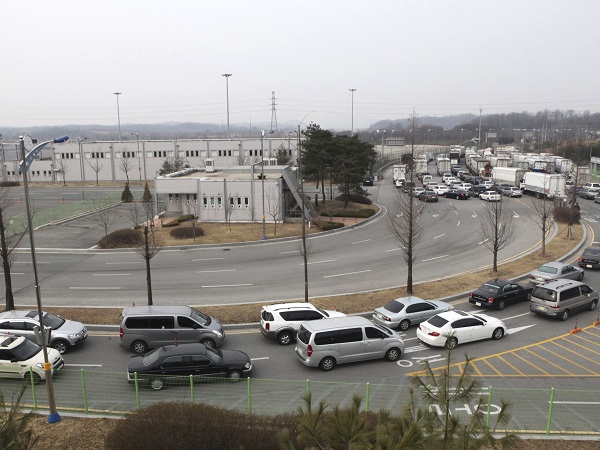North Korea blocks access to key industrial zone

South Korean vehicles wait to head to the North Korean city of Kaesong at the customs, immigration and quarantine office in Paju, South Korea, near the border village of Panmunjom, Monday, April 1, 2013. North Korea threatened in recent days to shut down a jointly run factory complex in Kaesong — the last remaining symbol of inter-Korean rapprochement. But officials in Seoul said hundreds of workers traveled as usual across the heavily armed border to the North Korean factory Monday as they have throughout the rising tensions. AP/Ahn Young-joon
SEOUL – North Korea blocked access to and from its joint industrial zone with South Korea Wednesday, a move that could sharply escalate tensions and fuel concerns the crisis on the Korean peninsula is spinning out of control.
The Kaesong industrial complex is a crucial source of hard currency for the regime in Pyongyang and seen as a bellwether of inter-Korean relations, beyond all the military rhetoric that regularly flies across the border.
The latest North Korean move fitted into a cycle of escalating tensions that prompted UN chief Ban Ki-Moon to warn Tuesday that the situation had “gone too far” as the US vowed to defend itself and regional ally South Korea.
Hundreds of South Koreans travel to and from Kaesong, which lies 10 kilometers (six miles) inside North Korea, every day, but officials said the normal morning crossing had been delayed Wednesday.
“North Korea has not yet given us the daily permission for the entry of 484 South Koreans into Kaesong today,” a South Korean Unification Ministry spokeswoman told AFP.
Article continues after this advertisementAnother 861 South Koreans are inside the complex and the first scheduled exit by some of them was also delayed.
Article continues after this advertisementIt was not immediately clear if the blocked movement was permanent, but the Unification Ministry stressed that plants in Kaesong were running normally.
“We are waiting, unable to leave,” Kim Dong-Kyu, a company manager currently in Kaesong told the YTN news channel.
“We don’t know the situation well but I’m not particularly worried.
“Plants are operating normally and the atmosphere here is like, business as usual. It doesn’t appear that the complex will be closed as far as I can tell,” Kim said.
North Korea has always been careful in the past not to allow crises on the Korean peninsula to impact Kaesong, which was established in 2004. Around 53,000 North Koreans work at plants for 120 South Korean firms at the complex.
The last time the border crossing was blocked was March 2009 in protest at a major US-South Korean military exercise. It reopened a day later.
Tensions have been soaring on the Korean peninsula since the North held a nuclear test in February, having launched a long-range rocket in December.
In a rare show of force in the region, Washington has deployed nuclear-capable US B-52s, B-2 stealth bombers and two US destroyers to South Korean air and sea space.
Standing side-by-side with counterpart South Korean Foreign Minister Yun Byung-se, US Secretary of State John Kerry denounced Tuesday an “extraordinary amount of unacceptable rhetoric” from North Korea in recent days.
“Let me be perfectly clear here today. The United States will defend and protect ourselves and our treaty ally, the Republic of Korea,” Kerry said.
He was speaking after the North triggered renewed alarm by warning it would reopen its mothballed Yongbyon reactor — its source of weapons-grade plutonium.
The recent posturing by new North Korean leader Kim Jong-Un was “dangerous and reckless,” Kerry said.
Earlier, Ban Ki-moon warned the situation was veering out of control and stressed that “nuclear threats are not a game.”
“The current crisis has already gone too far… Things must begin to calm down,” the former South Korean foreign minister said, adding that negotiations were the only viable way forward.
The North shut down the Yongbyon reactor in July 2007 under a six-nation aid-for-disarmament accord, and destroyed its cooling tower a year later.
Experts say it would take six months to get the reactor back up and running, after which it would be able to produce one bomb’s worth of weapons-grade plutonium a year.
North Korea revealed it was enriching uranium at Yongbyon in 2010 when it allowed foreign experts to visit the centrifuge facility there, but insisted it was low-level enrichment for energy purposes.
The North has substantial uranium ore deposits which provide a quick route to boosting reserves of fissile material, while plutonium has the advantage of being easier to miniaturize into a deliverable nuclear warhead.
Many observers believe the North has been producing highly-enriched uranium in secret facilities for years, and that the third nuclear test it conducted in February may have been of a uranium bomb.
Its previous tests in 2006 and 2009 were both of plutonium devices.
Originally posted at 10:13 am | Wednesday, April 3, 2013